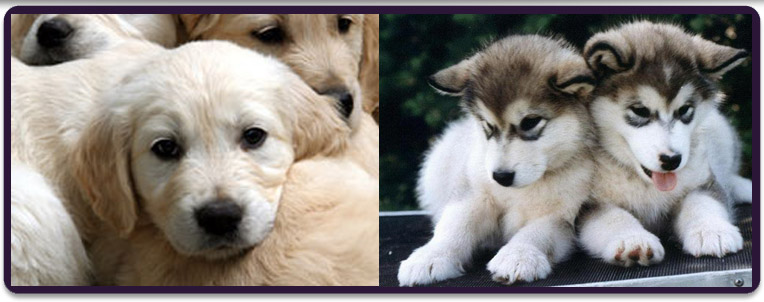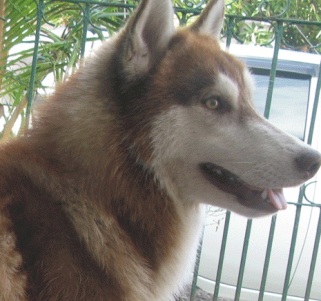
Copyright 2010 Puppy 4 Sale. Red Siberian Husky All Rights Reserved



Get the perfect puppy...
Red Siberian Husky
Home | Choosing the Right Puppy | Breeders | Puppy Names | Photo Gallery | Contact Us
Husky Puppy Info
Some information regarding the red siberian husky
The Siberian Husky was originally bred by the Chukchi, a tribe of Siberian nomads, to provide fast, economical transportation over the vast amount of frozen land.
The breed was unusually strong and agile and was able to swiftly cover long distances on a minimum amount of food. The breed is known for its gentle nature, the Chukchi dog often served as a soft, furry bed for the tribal children. Chukchis knew many a "three dog night".
A special relationship was born of mutual need and nurtured by mutual respect between the dog and its people. Together, they thrived in virtual isolation for centuries before the outside world discovered the dog and fell in love with it. Although the present day Siberian Husky has changed since coming to the U.S. around 1900, the breed still maintains most of the qualities that made the Chukchi sled dog such a prized possession
Originally breed to survive on a minimal amount of food, the Siberian Husky eats a substantially less food that other dogs of his size.
You must make sure to provide a balaced diet that is high in protein and fat. But, unfortunately, many commercial foods do not meet this need.
Many people prefer to make their own diets when it comes to the breed.
A holistic diet should include:
Protein : 45% of total volume
Ground Turkey: 85% of Total Protein
Fish: 15% of Total Protein
Carbohydrate: 45% of total volume
Sweet Potato: 60% of Total Carbohydrate
Brown Rice: 40% of Total Carbohydrate
Fiber Source:
Fruit/Vegetable: 10% of Total Volume
You may, also, consider adding vitamins and minerals to the dogs diet You can try some of the below supplements:
Bone Meal Powder
Raw Wheat Germ
Lite Salt
Sunflower Oil
Multi-Vitamin/Mineral
Ask your veterinarian for proper measurements that will best suit you dog.
Siberian huskies have a double coat- a soft undercoat and an outer coat (guard hairs). The double coat insulates them from both heat and cold, which is why they should never be shaved, even in the hottest climates. The topcoat is used to block the UV rays, as well, so shaving your husky, leads it with little protection; the topcoat, also, helps to cool the dog, so heatstroke is a concern when shaving the fur.
Twice a year the new guard coat coming in, pushes the undercoat out which results in a massive amount of shedding hairs, known as "blowing coat."
Regular grooming will help keep down fur balls in your home. It can be seen as the perfect opportunity to inspect the dog for any parasites, lumps, skin problems, ear problems, etc., that can become serious if undetected for long periods of time.
Siberian Huskies tend to be clean dogs, as when dirty they tend to clean themselves up, similar to cats, but that doesn't mean their grooming can be neglected, by any means.
The breed is a heavy seasonal shedder. They completly loose their undercoat twice a year. The entire shedding period tends to last about three weeks. With daily brushing you can easily cut down the number of "dust bunnies" in your home. Using a metal comb tends to work best.
You should only give baths when needed, as bathing too frequently will cut down essential oils i nthe dogs skin and fur. I would recommend bathing Siberian huskies outside, as to best prevent you shower drain from clogging.
Throughout the year, Siberian huskies require minimum grooming care. They fur does not need to be trimmed or shaved
Because the Siberian Husky is a working breed, is is a high-energy dog that requires a lot of exercise. This breed is one that needs early socialization and training, in addition to an exercise and training schedule that is kept up throughout the dogs life time. In the year 2000, the US Centers of Disease Control and Prevention performed a study that resulted in about 15 human fatalities attributed the husky-type dogs, excluding the Alaskan Malamute, that resulted between the years 1979 and 1997. So, if this isn't enough to persuade you into proper training, I don't know what else is. Just remember that an untrained, unexercised dog is one that will create problems later in his/her life. As a puppy, the behavioral problems may be cute, but as an adult, probably not.
When training a Siberian husky remember that the breed is both gentle and devoted, but stubborn, as well. The breed can easily become a dominant dog if not trained otherwise. So, do keep up basic training and commands such as sit, stay, wait, come, and leave it.
Husky Puppy Pictures
Digging is probably one of the more common behavioral concerns with huskies. It is attributed to their past lives, in which they dug holes in the snow for places to sleep. For the most part huskies will dig when and where they please. If you provide the dog with a place that he can dig, you will cut down the dog's digging problem. (Well, you'll cut down the holes throughout your yard.)Running away is another problem that you risk. Because the breed has a built in need to roam, the dog is prone to escape fence, leashes, and open doors. Make sure to keep the dog in a confined area. Keep gates locked close. Close doors tightly behind you. Make sure that collars cannot be slipped and leashes are held tight
Learn More about The Husky Puppy Below
Red Siberian Husky












